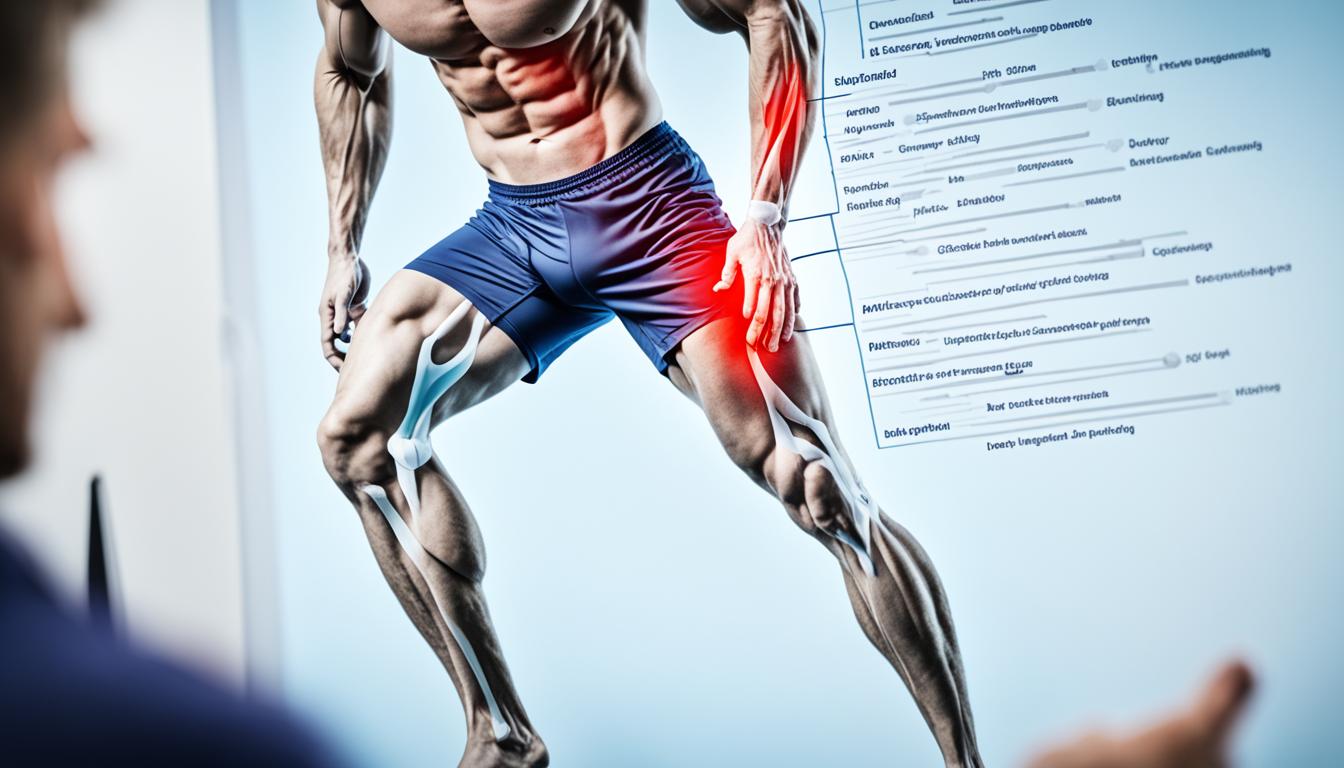Hamstring tendinopathy is a common sports injury. It causes sharp pain in the back of your leg. This issue is often found in dancers, runners, and athletes who use their legs a lot. The symptoms are pain, stiffness, swelling, and trouble moving or doing activities.
To check for hamstring injuries, doctors do physical exams and use tools like X-rays and MRIs. These tests show how bad the injury is. Treatments without surgery are common. They include rest, taking medicines, using ice, and physical therapy. But, in some tough situations, surgery might be needed.
For new ways to treat these injuries, stem cell therapy looks promising. It helps heal hamstring issues. Some methods of stem cell therapy for this are MFAT, BMAC, and PRP therapy. These methods use special injections to help the muscles recover.
Key Takeaways:
- Hamstring tendinopathy causes acute pain in the back of the leg and is common among athletes.
- The symptoms are pain, stiffness, swelling, and difficulty moving or doing activities.
- Doctors diagnose it with a physical exam and imaging like X-rays and MRIs.
- Treatments without surgery include rest, medicines, ice, and physical therapy.
- Sometimes, surgery is needed in severe cases.
- Stem cell therapy brings new treatment options such as MFAT, BMAC, and PRP for hamstring injuries.
Causes and Risk Factors of Hamstring Strains
Hamstring strains happen when the hamstring muscles are pulled too hard. This often occurs during activities like running or jumping. These actions can put too much stress on the hamstrings, leading to potential strains.
Having a past hamstring injury makes you more likely to strain it again. This makes the muscles weaker and more prone to future strains.
Tight hamstrings and lack of flexibility also up the risk. If the muscles are tight, they can easily get hurt. Muscle imbalances, like weak glutes, can also strain the hamstrings too much. This makes strains more likely.
If your job is physically tough on your legs, you might be at a higher risk for strains. Doing exercises to condition your body and keeping good form can decrease this risk.
Prevention Strategies for Hamstring Strains
To avoid hamstring strains, prevention is key. Starting with a good warm-up before exercise can prepare your body. Include stretches that focus on the hamstrings and the rest of the legs.
Regularly stretching helps keep your muscles flexible and less tight. Make sure to do both static and dynamic stretches right to prevent injury.
Strengthening the hamstrings and glutes can offer extra support. Strong muscles are less likely to get hurt during physical activities.
Using the right form and being careful with how you move is crucial. Always keep your posture and avoid sudden movements. This, along with slowly increasing the intensity of your activities, can protect against strains.
Knowing how hamstring strains happen can help you prevent them. By doing warm-ups, stretching, and strengthening exercises, you can lower your risk. This lets you enjoy sports safely and stay healthy.
Diagnosing and Treating Hamstring Strains
Getting a hamstring strain diagnosed starts with a full check-up from a doctor. They might also use X-rays or MRI scans to see the injury’s size and to make sure it’s not something else. This check helps figure out how best to treat the person.
For not so bad strains, the RICE method works well. This means resting the leg, icing it to cut down on pain and swelling, wrapping it with a bandage to help, and keeping it raised. Pain meds bought at the store can also help.
Doing physical therapy alongside the RICE method is key. Exercises made to stretch and strengthen the leg get it back to normal. Massages can loosen up tight muscles and help them heal. If the strain is serious, surgery might be needed to fix the muscle.
To keep hamstring injuries from happening again, staying in good shape is a must. It’s important to warm up well and to do exercises properly, especially for people who are very active. Doing this also cuts down on the chance of getting hurt again, which is great news for athletes and those who do tough jobs.

